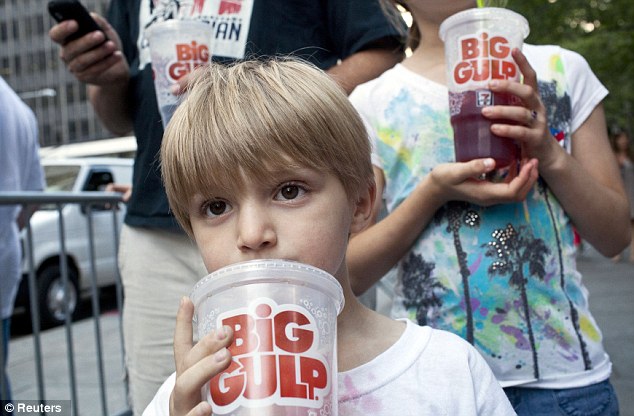
Pic courtesy – Reuters
- Kids guzzle 7 trillion calories from fizzy drinks each year – Just say No : A soda less a day keeps the doctor away, says Harvard Director
- Kids guzzle average 270 calories a day from fizzy drinks, finds study
- Kids chug an estimated 270 calories per day from sugary drinks, which accounts for anywhere from 15 to 25 per cent of the daily recommended amount for children
- Sweet drinks are a major factor to rising childhood obesity rates – which have tripled since 1980
- Health officials estimate 17 per cent of U.S children (12.5 million) are obese
- Beverage lobby hits back, saying sugary drinks are not the only contributing factor to obesity.
The average American child consumes nearly 300 calories from liquid sugar alone each day – a combined total of 7 trillion calories each year, a public health professor suggests.
Dr Steven Gortmaker, Director of the Harvard School of Public Health Prevention Research Center, is sounding the alarm and pushing for increased government involvement to keep sodas and sugary drinks away from kids, as part of his presentation at the Obesity Society’s Annual Scientific Meeting in San Antonio, Texas on September 23.
The sweet drinks are increasingly a poison to younger Americans, aged two to 19 – a population of an estimated 73.5 million, as they contribute to the ever-growing childhood obesity rates in the U.S.
Young people chug an estimated 270 calories per day due to sugary drinks, accounting for over 19 billion calories a day nationwide.
Calorie recommendation for children (depending on age and gender) range from 1,200 to 2,200, so calories from sugary beverages, on average, accounts from anywhere from 15 to 25 per cent of their daily recommended allotment.
Sales of drinks for these mini-consumers totaled an estimated $24 billion in sales, according to Scientific America.
New information on beverage consumption by children in the U.S., comes as the childhood obesity epidemic continues to spread with rates among adolescents having tripled since 1980. The Centers for Disease Control and Prevention shows that 17 per cent of American youth (or 12.5 million) are obese. Gortmake’s presentation in Texas comes on the heels of extensive research in the September issue of the New England Journal of Medicine on the impact of sugar-sweetened beverages on childhood obesity rates.
‘During the past 30 years, the consumption of sugar-sweetened beverages has increased dramatically. Compelling evidence supports a positive link between the consumption of sugar-sweetened beverages and the risk of obesity,’ the authors of the academic paper, Sugar-Sweetened Beverages and Genetic Risk of Obesity informs.
Video games can increase Oxygen Intake, heart rate and energy expenditure in Children, says Researchers
Pic courtesy : Flickr/iranus
A new study shows that active video games — such as “Dance Central” and “Kinect Sports: Boxing” – can increase oxygen intake, heart rate and energy expenditure in children, leading researchers to believe that the games may be a way to combat childhood obesity.
According to the Centers for Disease Control and Prevention, childhood obesity has tripled in the last 30 years to nearly 20 percent of U.S. children and adolescents. In 1980, about 7 percent of children aged 6 to 11 were obese. Similar increases were seen in adolescents between the ages of 12 and 19, whose obesity numbers increased from 5 percent to 18 percent over the same time period. As of 2008, more than one-third of U.S. children and adolescents were overweight or obese.
For the study, which was published online on September 2012 in the Archives of Pediatrics & Adolescent Medicine, researchers measured the heart rate, VO2 (oxygen uptake) and energy expenditure for 18 children – 10 boys and 8 girls – during rest, sedentary game play or controller-based video games and active game play, which used a webcam-style sensor and device instead of a controller to detect the player’s movements. The children were between the ages of 11 and 15.
Energy expenditure increased by 150 percent when kids played “Dance Central” and 263 percent when they played “Kinetic Sports Boxing” above their resting values. In comparison, energy expenditure for these two games were 103 percent and 194 percent higher than traditional video gaming levels respectively.
While the researchers may think active video games qualify as exercise given their findings, whether or not it will curb obesity rates remains to be seen. A study in February found kids given active video games were no more fit than kids who were given normal games.
It is recommended by the Centers for Disease Control and Prevention that children get 60 minutes or more of aerobic exercise each day, with intense activities like running at least three times a week. Muscle-strengthening activities and bone strengthening activities are also recommended three times a week.
– Sources : Archive of Pediatrics and Adolescent Medicine | Childhood Obesity Facts







